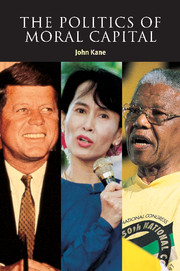Book contents
- Frontmatter
- Contents
- Acknowledgments
- Introduction
- Part I Moral capital
- Part II Moral capital in times of crisis
- Part III Moral capital and dissident politics
- 5 Nelson Mandela: the moral phenomenon
- 6 Aung San Suu Kyi: her father's daughter
- Part IV Moral capital and the American presidency
- Epilogue
- Bibliography
- Index
5 - Nelson Mandela: the moral phenomenon
Published online by Cambridge University Press: 22 September 2009
- Frontmatter
- Contents
- Acknowledgments
- Introduction
- Part I Moral capital
- Part II Moral capital in times of crisis
- Part III Moral capital and dissident politics
- 5 Nelson Mandela: the moral phenomenon
- 6 Aung San Suu Kyi: her father's daughter
- Part IV Moral capital and the American presidency
- Epilogue
- Bibliography
- Index
Summary
Under a government which imprisons any unjustly, the true place for a just man is also in prison.
Henry David ThoreauIn July 1997, Nelson Rohlilahla Mandela (commonly known among his own people by the African name, Madiba) spoke to the Oxford Centre for Islamic Studies on two themes that lay at the heart of his efforts to construct the foundations for a new South Africa – reconciliation and renaissance. The Director, Farhan Nizami, thanked Mandela for the “extraordinary honour” and “extraordinary favour” he had bestowed, declaring that “Your willingness to lend your moral authority to the aim of the centre surely will inspire others to recognise the necessity of tolerance and mutual respect between different cultural traditions in the world.” Mandela replied that he had been eager to accept the invitation, conscious of a debt owed to religious leaders and missionaries who had educated black people in the days of their malign neglect by white rulers. Though he did not mention it, he was no doubt also conscious of the debt that he owed to the friendship and financial aid of the Saudi royal family, who had also donated the money to construct a new building for the center in the heart of Oxford. Bearing a large dome and a 33–meter minaret, this building had been vigorously opposed by members of the Oxford establishment.
- Type
- Chapter
- Information
- The Politics of Moral Capital , pp. 118 - 146Publisher: Cambridge University PressPrint publication year: 2001

